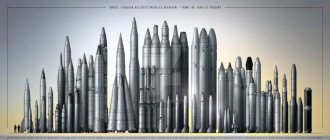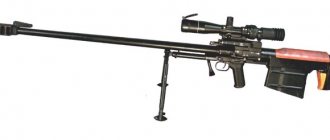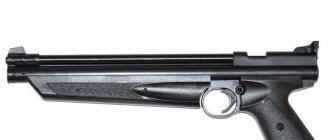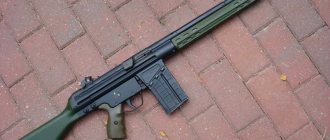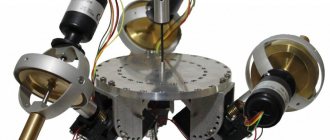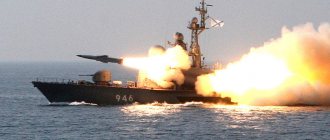Today, the most powerful missile on Earth is the RS-36M or SS-18 “Satan” (according to the classification of NATO experts), in Russia this weapon is called “Voevoda”. It has been in service with the Strategic Missile Forces since the late 70s to this day.
This missile is considered the most terrible, since there is no point on planet Earth that is unattainable for it, and in a few minutes its warhead will wipe out all life within a radius of 500 km2. That is why other countries consider the “Voevoda” to be the creation of the devil. The presence of these weapons stops aggression from foreign countries and serves as a deterrent to the outbreak of a global war.
History of creation
The R-36M heavy-class intercontinental ballistic missile was developed at the Yuzhnoye Design Bureau (Dnepropetrovsk). On September 2, 1969, a resolution was adopted by the Council of Ministers of the USSR on the creation of the R-36M missile system. The rocket had to have high speed, power and other high characteristics. The designers completed the preliminary design in December 1969. The intercontinental nuclear ballistic missile provided for 4 types of combat equipment - with multiple, maneuvering and monoblock warheads.
Yuzhnoye Design Bureau after the death of the famous M.K. Yangel was headed by Academician V.F. Utkin. When creating a new missile, designated R-36M, we used all the experience accumulated by the team when creating previous missile models. In general, it was a new missile system with unique performance characteristics, and not a modification of the R-36. The development of the R-36M proceeded in parallel with the design of other third-generation missiles, the general characteristics of which were:
- use of MIRVs;
- use of an autonomous control system with an onboard computer;
- placement of a command post and missiles in highly secure structures;
- the possibility of remote re-aiming immediately before launch;
- availability of more advanced means of overcoming missile defense;
- high combat readiness, ensuring quick launch;
- use of a more advanced management system;
- increased survivability of complexes;
- increased radius of destruction of objects;
- increased combat effectiveness characteristics provided by increased power, speed and accuracy of missiles.
- the radius of the R-36M damage zone with a blocking nuclear explosion is reduced by 20 times compared to the 15A18 missile, resistance to gamma-neutron radiation is increased by 100 times, resistance to x-ray radiation is increased by 10 times.
The R-36M intercontinental nuclear ballistic missile was first launched from the Baikonur test site on February 21, 1973. Tests of the missile system were completed only by October 1975. In 1974, the first missile regiment was deployed in the city of Dombarovsky.
The fight for survivability
Silo launcher hatch
The survivability of the complex, in particular silo launchers, has been significantly increased, which allows launches even after a nuclear strike. The missile in flight became virtually invulnerable to the damaging effects of a nuclear explosion. This was achieved through the use of a special multifunctional coating and a unique head fairing.
Quantity and cost
Missiles of this type are the most powerful of existing intercontinental missiles; they are capable of delivering a crushing nuclear strike to the enemy. In the West, these rockets are called “Satan”.
As of 2022, the Russian Strategic Missile Forces have 75 combat missile systems equipped with Satan missiles (750 nuclear warheads in total). This amounts to almost half of Russia's nuclear potential, which totals 1,677 warheads. By the end of 2022, most likely, some more Satan missiles will be removed from Russia’s arsenal and replaced with more modern missiles.
Go underground
Until the 1960s, strategic missile weapons in the USSR were located at open launch complexes; the launch facilities were almost not camouflaged. But with the development of reconnaissance and surveillance systems, missiles and all technological equipment were literally “buried” in the ground. The first silo complexes were intended for long-term storage of R-12U and R-14U missiles. Single-stage medium-range missile systems made it possible to send nuclear “parcels” two and four thousand kilometers, respectively.
The silos were modernized and improved for each new type of missile, and their level of security increased. For example, more modern underground launch pads for UR-100 ballistic missiles already had quick-opening hinge systems - before launch, the “lid” weighing more than a hundred tons was automatically folded back in 30 seconds. The missiles were filled with fuel at the manufacturing plant and “packed” into special transport and launch containers, after which they were lowered into the silos. And they remained there until the end of their service life.
RIA Novosti / Sergey Kazak / Launch of the RS-18 ballistic missile from the Baikonur cosmodrome
Structural features of the Satan rocket
The R-36M is a two-stage missile using sequential stage separations. Tanks with fuel and oxidizer are separated using a combined intermediate bottom. The onboard cable network and pneumohydraulic pipes were laid along the hull and covered with a casing. The first stage engine has four autonomous single-chamber liquid propellant engines with a closed-cycle turbopump fuel supply. The rocket is controlled in flight by commands from the control system. The second stage engine contains a single-chamber propulsion engine and a four-chamber steering rocket engine.
All engines operate using nitrogen tetroxide and UDMH. The SS-18 implemented many original technical solutions. In particular, chemical pressurization of tanks, braking of separated stages by the outflow of pressurization gases, etc. An inertial control system was installed in the “Satan”, operating using an on-board digital computer complex. When used, high shooting accuracy is ensured.
It is also envisaged that launches can be carried out even in situations where nuclear weapons are used by the enemy near the missile location. "Satan" has a dark heat-protective coating. It is easier for them to overcome radiation dust clouds formed as a result of the use of nuclear weapons. With special sensors that measure gamma and neutron radiation when overcoming a nuclear “mushroom”, it is registered and the control system is turned off, and with the engines functioning. At the exit from the danger zone, the control system is automatically turned on and the flight path is corrected. Actually, these ICBMs had particularly powerful combat equipment and a complex for overcoming missile defense.
Be that as it may, to this day the Satan ballistic missile still remains an unsurpassed and quite formidable Russian weapon.
Nuclear strike: Russian “Sineva” against the American Trident
Military expert Mikhail Timoshenko compared the capabilities of sea-based ballistic missiles with nuclear warheads - Russian and American Trident. The expert recalled that Sineva missiles are in service with Project 667BRDM Dolphin-class submarines; the Americans are equipped with Trident missiles on Ohio-class missile-carrying submarines.
"Sineva" has a liquid engine, with its help it is possible to solve complex control and maneuvering problems. A liquid-fuel rocket obviously has better characteristics than a solid-fuel rocket, this is physics, and there’s nothing you can do about it,” the expert is convinced.
According to Mikhail Timoshenko, the Russian missile can be called unique in its characteristics - Sineva weighs about 40 tons, and Trident - 60. Moreover, Sineva’s range is higher than that of its American counterpart.
“The American rocket without load flew 11,300 kilometers, our rocket with a full standard load – 4 blocks, flew 11,500 kilometers, that’s the difference between the design of one and the other machine,” said Tymoshenko.
The expert is also convinced that the accuracy of both missiles is approximately the same, despite numerous open source data reporting the opposite.
“The Americans write about the Trident that it has an accuracy of 90-120 meters, in fact, the Sineva has the same accuracy, we just standardly underestimate our accuracy in open sources, and the Americans standardly overestimate it. They need to declare their effectiveness before Congress,” Tymoshenko explained.
The Russian rocket also has the advantage of being able to fly along a flat trajectory, which the American model does not have.
“A flat trajectory is when the missile immediately falls on the combat trajectory. The blocks accelerate parallel to the surface of the earth, which shortens the flight time by almost half and the enemy has no time left to intercept,” the military expert noted.
According to Tymoshenko, the Russian Navy has less than a dozen submarines equipped with Sineva in service - this number is enough to cause irreparable damage to the enemy in the event of a conflict, even attacking it directly from the pier.
“With a return salvo, we get the launch of about 400 warheads. This will be enough to specifically destroy cities, factories of the military-industrial complex, and ports of a potential enemy,” Mikhail Timoshenko summed up. (https://tvzvezda.ru/news/forces/content/201412060924-21cf.htm#)
Performance characteristics
TTHR-36M “Satan” is unique and still has no analogues in the world. The missile has excellent combat and technical characteristics. The most significant of them are presented in the table.
| Rocket length, m | 34,3 |
| Diameter, m | 3 |
| Weight at start, t | 211,4 |
| Head mass, t | 8,47 – 8,73 |
| Fuel mass, t | 180 |
| Stage I liquid fuel, t | 150,2 |
| Stage II liquid fuel, t | 37,6 |
| Dilution stage liquid fuel, t | 2,1 |
| Oxidizer | nitrogen tetroxide |
| Energy-weight perfection coefficient Gpg/Go, kgf/tf | 42.1 |
| Maximum missile flight range, km | 16000 |
| Number of steps | 2 |
| Flight reliability factor | 0,974 |
| Reliability level | 2 |
| Extended service life, years | 25 |
| Warranty service life, years | 15 |
| Air temperature for the possibility of combat use of a missile | from -50 to +50°С |
| Wind speed for combat use, m/s | up to 25 |
| Rocket flight speed, m/s | up to 3120 |
| Number of combat warheads in one missile | 10 |
| Control system | inertial autonomous |
| Startup type | Mortar launch from a silo |
| Radius of guaranteed accurate hit to the target, m | 1 000 |
Despite repeated attempts by our so-called Western “partners” to destroy or significantly reduce the stock of these missiles in the country’s nuclear shield system, “Governors are still serving on the borders of Russia. They will work for the defense of the country in the Strategic Missile Forces of the Russian Federation until 2026.
About the design of the SS-20
The creation of the Pioneer missile system began in 1971 at MIT. The process was led by Nadiradze A.D. The engineers were given the task of developing a new medium-range missile, through which it would be possible to destroy a target at a distance of up to 5 thousand km. In addition, the designers worked on the remaining elements of the complex. For example, above a mobile launcher, which was planned to be placed on a wheeled chassis. To facilitate the process, the engineers used the Temp-2S intercontinental missile as a basis. The main work was carried out by MIT employees. In addition, such organizations as NPO Soyuz and Central Design Bureau Titan were involved in the design of the Pioneer rocket complex. Due to the fact that some elements were borrowed from the SS-16 project, the construction of the new complex was planned to be completed in 1974.
Acquaintance
The Pioneer missile system is listed in the technical documentation under the designation GRAU 15P645 RSD-10. In NATO and the USA it is classified as mod.1 Saber SS-20, which means “saber” in Russian. It is a mobile ground-based missile system (PGRK) using a solid-fuel two-stage medium-range ballistic missile 15Zh45. Developed at the Moscow Institute of Thermal Engineering (MIT). The Pioneer missile system has been in service since 1976.
A little history
In 1950 in the Soviet Union, rocket science, according to experts, was carried out in the “liquid” direction. Only in July 1959 was decree No. 839-379 issued, according to which it was decided to refuel surface-to-surface combat missile systems with solid fuel. The initiator of this direction, as well as the resolution itself, was D.F. Ustinov. At that time he was the chairman of the Commission dealing with military-industrial issues.
It was planned to design completely new operational-tactical complexes, designed for a flight range of 600 km, strategic (2,500 km) and intercontinental (10 thousand km), which would run on solid fuel. In 1961, the Soyuz Scientific Research Institute of Chemical Technology (NIHTI) developed a solid fuel mixture recipe. In the same year, the first domestic solid-fuel complex “Temp-S” (SS-12) was created, using a guided ballistic missile with a range of 900 km. In 1972, the preliminary design of the Temp-2S (SS-16) complex was ready, and in 1974 the PGRK itself was ready. It was on the basis of the Temp-2S that the Pioneer missile system was made (photo of this PGRK is below).
About the launcher
The main elements of the Pioneer missile system are represented by the 15Zh45 ballistic missile and the 15U106 self-propelled launcher. Due to this architecture, with the help of the PGRK it was possible to patrol at a great distance from the base, and upon receiving an order, launch a missile in a short period of time. The self-propelled launcher was created by employees of the Volgograd Central Design Bureau "Titan". As the basis for the vehicle, engineers used the MAZ-547V chassis, which has a 12 x 12 wheel arrangement.
15U106 was more than 19 m long and weighed 80 tons (if a transport and launch container and a missile were installed on it). The presence of a V-38 diesel engine, designed for 650 horsepower, made it possible to accelerate the unit to 40 km/s on a flat road. According to experts, the 15U106 was capable of overcoming inclines of up to 15 degrees, three-meter ditches, and crossing water obstacles if the depth did not exceed 1.1 m. In order to be able to place a transport and launch container (TPC) on the installation and lift it vertically before launching the rocket, The car was equipped with a lifting unit. It could be controlled using hydraulic drives.
About TPK
Engineers used fiberglass as a material for the manufacture of the 15Ya107 transport and launch container. In order to make the TPK stronger, it was reinforced with titanium rings. The container had a multilayer structure, namely, two fiberglass cylinders were separated by a heat-insulating layer. The length of the TPK turned out to be no more than 19 m. A hemispherical cover was attached to the front (upper) end with pyrobolts. For a mortar launch of a rocket, the rear (lower) end of the container was equipped with a PAD housing (powder pressure accumulator).
TTX
The Pioneer complex has the following characteristics:
- The type is a medium-range ballistic missile.
- The shooting accuracy indicator (FI) was 0.55 km.
- Range – up to 5 thousand m.
- The rocket can be launched from an open area and from a special protected structure “Krona”.
- Hit probability – 98%.
How did the complex work?
The cold method was used to launch the Pioneer rocket. The bottom part of the container was equipped with a powder charge, due to the combustion of which the rocket was ejected from the TPK. In an effort to improve the design, engineers decided to connect the powder accumulator to a separate cylindrical element. In other words, it turned out to be a retractable glass inside the container. When the rocket was launched, the powder gases affected it and the “glass”. As a result, it sank to the ground, thus forming additional support for the entire transport and launch container. This part also served another purpose. In the event of abnormal combustion of a charge, which could harm the rocket, the pressure inside the container was relieved using a “glass”. The rocket was held inside the TPK by detachable support-driving belts (OSB), which were also used as a shutter. After the rocket took off, these belts were shot off. As a result, they scattered to the sides at a distance of up to 170 m. According to experts, because of this feature, it was impossible to carry out a group launch at one site. Otherwise, the launching PGRK would have severely damaged surrounding objects.
Device Features
At the development stage, KB Energomash prepared a new model of the RD-264 power unit, consisting of 4 single-chamber RD-263 rocket launchers. It was located on the first stage of the rocket. The second one was equipped with a single-chamber propulsion motor RD-0228 from specialists from the Chemical Automation Design Bureau. A four-chamber was used as a steering wheel.
A unique computer for that time was responsible for the accuracy of hitting the target. The thermal protection coating allowed the system to function even if the area where the mines were located was subject to nuclear bombardment. In this case, the power plant is turned off by gamma-neutron sensors, but the engines will remain in working order. This will allow Satan to continue its flight and hit a previously planned target, regardless of obstacles, including the enemy’s nuclear potential and missile defense systems.
Fool America
The test launches of the rocket itself were closely monitored in the United States. They were especially interested in multiple warheads - this was our first missile with such a warhead design. During test launches at the Kamchatka Kura test site, an American reconnaissance ship was constantly in neutral waters, and a flying laboratory based on a B-52 bomber was patrolling in the air. As soon as the plane took off for refueling, ours carried out the launch.
Unkind “svetka”: why soldiers criticized SVT
A huge advance was the ability to retarget a missile before launch—also a first for an ICBM. The Satan's on-board electronics were maximally protected from both the consequences of a nuclear explosion and electronic jamming systems - for this purpose, the cable network was laid deep in the hull, covered with units and insulating materials. On the outside, the RS-36M was protected by a shell made of thermal and radio-absorbing materials. In case the engines stopped in flight due to ionizing radiation, they were restarted. A direct hit by a nuclear warhead into the R-36M launch silo could only delay the missile launch by 3-5 minutes - so that the dust could settle.
Combat use
Russia currently has 75 Satan ballistic missile systems in service. The missiles contain 750 nuclear warheads. In total, the Russian nuclear shield has more than 1,670 warheads, and half of them are “Satan”. But since 2015, some of the missiles of this modification are gradually being replaced by more modern combat missile systems.
The Satan has never been used in combat due to the fact that this very powerful deadly weapon can cause irreparable damage to the environment and humanity as a whole. The use of even one missile can lead to the disappearance, for example, of an entire state in the United States. In the mid-80s. The R-36M was massively replaced with improved units.
Instead of disposal due to its high cost, it was decided to use them to launch artificial satellites.
The R-36M is inaccessible to electromagnetic pulses, since the Voevoda control system is duplicated by pneumatic and electronic automatic weapons. To overcome the enemy's missile defense, "Satan" was equipped with decoys, both light and quasi-heavy, dipole reflectors and active jammers.
Thanks to the efforts of Soviet scientists and designers who worked on the creation of the Satan or Voevoda ballistic missile system, the most unique and powerful weapon on the planet was created. These intercontinental missiles are the pride of the Russian Strategic Missile Forces in our time.
Despite the enormous efforts made, potential adversaries of the Russian Federation have so far been unable to create anything comparable in power and efficiency. Russia need not fear for the safety of our Motherland and its inhabitants.
Margin of safety
The Voevoda complex has passed its quarter-century mark at the zenith of glory and power. He still has no equal and remains in office as before. Five years ago, after another successful firing, the Russian defense department decided to extend its service life for at least the next 23 years.
“Voevoda” is a weapon of retaliation. According to some reports, of the 350 strategic missiles in service today, a fifth are accounted for by it. And in 3-4 years, solid reinforcements are expected - the new generation strategic complex Sarmat.
Notes
- ↑
- ↑. MilitaryRussia.Ru - domestic military equipment (after 1945). Retrieved June 30, 2022.
- International Institute for Strategic Studies.
The Military Balance 2016 / James Hackett. - London: Taylor&Francis, 2016. - P. 189. - ISBN ISBN 9781857438352. - (English). Soviet Armed Forces 1945-1991
. Michael Holm's website. Retrieved February 18, 2013. - (English). Soviet Armed Forces 1945-1991
. Michael Holm's website. Retrieved February 18, 2013. - (English). Soviet Armed Forces 1945-1991
. Michael Holm's website. Retrieved February 18, 2013. - (English). Soviet Armed Forces 1945-1991
. Michael Holm's website. Retrieved February 18, 2013. - . yuzhnoye.com.ua. Retrieved August 29, 2022.
- (unavailable link). Retrieved June 15, 2012.

